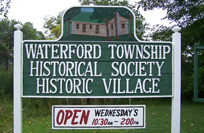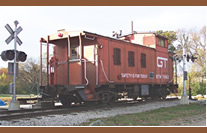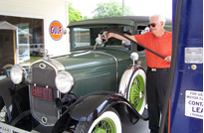This page contains the full history of all our buildings. For a briefer version, click here to download our Walking Tour brochure.
Museums
Hatchery House
 The Hatchery House property (4490 Hatchery Road) is located on the southwest corner of the southeast quarter of section 10, plat 24. This parcel of land was owned by Lewis L. Dunlap in 1864 and later sold to John Judd in 1872.
The Hatchery House property (4490 Hatchery Road) is located on the southwest corner of the southeast quarter of section 10, plat 24. This parcel of land was owned by Lewis L. Dunlap in 1864 and later sold to John Judd in 1872.
The Hatchery House is a Sterling Home, Senator, Model B, a popular pre-cut/mail-order home offered by the International Mill and Timber Company of Bay City between 1916 and 1922. Sterling Homes offered to customize the home to the owner specifications for a small charge. Ours differs slightly from the basic plan.
Architecturally, the house is known as a Four-Square (1905-1930), a style that was made popular directly and exclusively through the catalogs of Aladdin, Lewis-Liberty, Sterling, Sears, Montgomery Ward, and numerous smaller manufacturers. The Four-Square is the easiest of American architectural styles to identify because it has one standardized form. They are simple two story structures, square or rectangular in plan without complementing wings or additions. The hip roof is a required feature of the style, typically punctured by a dormer window. The front porch is also a requirement of the style and usually extends the full width of the facade.
The Four-Square was a particularly popular model as many variations could be made to make the style economical with significant savings. The Hatchery House follows the rustic views of the Arts and Crafts Movement (1905-1920). The Great Depression stifled popularity of the style and it is only recently that the Four-Square has been accepted as a recognized architectural style. Our Hatchery House is the only Senator B that the Bay City Historical Society is aware of with the original floor plan.
The House a Bass Station Built
Before the Hatchery House was built on this location, the property was owned by the Michigan State Fish Commission. The fish hatchery was opened by the state on the property in 1903 as the Drayton Plains Station. It was built as an additional site to raise bass fingerlings. When the state purchased it, there was a power dam, a mill building, a residence and 18 acres of land. The brick residence was across the wooden bridge and across Hatchery Road from the current Hatchery House. This was the home of the Mill operator of the original Drayton Mill built in 1835 and was now used for the overseer of the Drayton Plains Station. The mill building was the original 1835 grist mill and was located across the river from the current Hatchery House. The 18 acres included the present Drayton Plains Nature Center grounds.
Around 1917, a new overseer's home was ordered to be built on higher ground. This was the present Hatchery House. The house was ordered from Bay City, carried by horse and buggy from the Drayton Plains Depot, and assembled by the prisoners from Camp Pontiac. It was originally painted two-tone gray and white, with black window sashes and cedar shingle roofing.
Although built complete with all its electrical wiring, the Hatchery House did not have working electricity until power lines came through the area in1921; kerosene lamps were used for the first 2 years of occupancy.
1921-1924: Mr. Harold Hughes, Assistant Manager of the Drayton Plains Station, moved in with his bride, Velma, a Waterford Township teacher. Velma painted fish on the kitchen cupboards and on the bathtub. She also painted "Cleanliness is next to Godliness" on the tub. She had organdy curtains tied back at all the windows and window boxes. In 1924, Harold was transferred to Grand Rapids and the Comstock Fish Station.
1924-1925: Seymour Bromer moved into the home for one year.
1925-1941: Superintendent A.T. Stewart and his wife Arletta, moved in. By this time, the old brick overseer's home had been torn down and the Hatchery House Senator B was now the Superintendent's home.
1941-1942: Nick O'Dea and his family moved in.
1942-1961: The Hughes came back to the Hatchery House. Harold was then the Superintendent of the Drayton Plains Fish Hatchery. They lived there until 1961 when Hughes retired.
1962: Operations at the Drayton Plains Fish Hatchery ended for good.
1964 or so: The newly formed Drayton Plains Nature Center, Inc. purchased the land minus the four acres of the current Fish Hatchery Park.
1962-1972: This four acre parcel of land, including the Hatchery House and buildings, was still owned by the State of Michigan. Mr. Cliff Fuller of the Department of Natural Resources lived in the Hatchery House at this time.
1972- 1981: Mr. And Mrs. Chuck and Helen Welsh and children moved into the home.
1981-1991: The Michigan Department of Transportation used the Hatchery House for a field office.
1991 to present: The Waterford Parks and Recreation Department purchased the four acres and the Hatchery House from the State of Michigan for one dollar. Four more acres to the west were immediately acquired, and the total 8 acres was turned into Fish Hatchery Park.
1992 to present: The Hatchery House was vacant until the first part of 1992 when it was offered to the Waterford Historical Society to be used for their headquarters. The Historical Society renovated the inside and Parks and Recreation took care of the outside. The first meeting was held in the house in May 1992.
The Drayton Plains State Fish Hatchery
Starting around 1913, the Drayton Plains Station began to be called the "Drayton Plains Hatchery". By 1934, the name was officially changed to "The Drayton Plains State Fish Hatchery", and remained thus until closing in 1962.
Many improvements to the buildings and grounds had been made along the way.
1904-1905: construction of ponds and their connections, grading, repairs to dam and buildings and rearranging land to conform to the needs of the Fish Station was done. A boat house was built (and still exists today). The original Mill building was moved across the river to sit next to the boathouse and was then used as the Bass Station's main building.
1905-1906: Additional rearing ponds constructed.
1907-1908: Fencing installed, trees planted, new horse barn constructed, gravel drives and more ponds constructed.
1935-1940: A complete modernization and enlargement of the Fish Hatchery took place, with many of the older original buildings being torn down. Over 300,000 yards of dirt were removed, 5500 feet of water supply pipe were laid, and 2600 feet of graveled roadway were constructed. The total area of the hatchery grounds is 87 acres, of which 47 acres are in ponds. The Station now had eleven rearing ponds, 10 experimental ponds, six exhibition ponds, hatchery building, garage, workshop, superintendent's residence, and foreman's residence.
1962: Operations at the Drayton Plains Fish Hatchery ended.
Donations in the log cabin:
Hanging lights by Bob & Norma Smithson
Track lights by the Rotary Club of Waterford
Monetary donations by Dora Tedder
The floor by the Waterford Village School Junior Historical Society
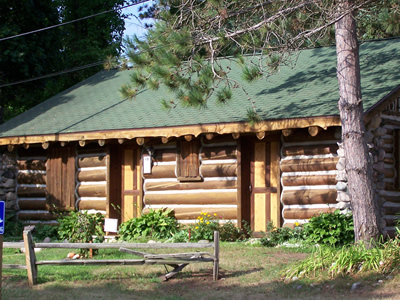 Lots 3, 4 and 5, on which the cabin sat, was part of the land granted to Alpheus Williams by the government and recorded in 1825 as being the northwest quarter of Section 4, Town 3 north, Range 9 east, 161.40 acres in the county of Oakland and the Territory of Michigan. It was located across from where Andersonville Road ends onto Dixie Highway.
Lots 3, 4 and 5, on which the cabin sat, was part of the land granted to Alpheus Williams by the government and recorded in 1825 as being the northwest quarter of Section 4, Town 3 north, Range 9 east, 161.40 acres in the county of Oakland and the Territory of Michigan. It was located across from where Andersonville Road ends onto Dixie Highway.
The above lots were included in the sale to Horace Steevins in 1842 from Fredrich Steevins (correct spelling of Steevins). Horace Steevins then sold the lots to William Windiate in 1844.
In 1845, the area was platted and called the Windiate Addition. Elizabeth inherited the lots in 1845 upon her husband's death. In 1915, a strip of land 66' wide was taken by the State for the Saginaw Turnpike. The land was clear of all mortgages in 1922. That is the last entry in the Abstract of the Windiate Addition about these lots.
Mr. And Mrs. George and Agnes Flickinger had the log cabin built by Jim Stites in the early 30's. They rented I tout as a gas station in 1934. It was then sold to Mr. And Mrs. Robert and Edith Bliss. They purchased a section of land on the N.W. to make an addition.
It was a Variety Store which sold children's clothes, yard goods, needles, thread, buttons, etc.
In the late 50's, early 60's it was owned by Florence and George Engel.
Following that it was a sign shop owned by Howard Husted. We do not know when Mr. Husted left.
In 1991, Mr. Victor Gerhardt purchased the land. The store was vacant. A grant from the C.D.G.B. was researched by Bob Vallina, Director of Community Planning and Development. He received the grant and it was passed by the Township in March, 1994.
The grant money was to move and to cover only the restoration of the outside of the cabin. The Historical Society finished the inside from donated funds.
The land at the Hatchery House site, where the log cabin now sits, was prepared for the foundation during the last week in August, 1994. The cabin was moved September 30, 1994. Restoration was started in March 6, 1995 with an expected completion date of May 31, 1995 but due to weather conditions, it was not completed until July 1995. It was dedicated on July 30, 1995.
We celebrated our first National Log Cabin Day on June 29-30, 1996 with exhibits, a Living History encampment, a book sale and White Elephant sale. The American flag was raised over the log cabin for the first time. We also had a cancelled stamp made for the occasion. It was a fun day attended by over 200 people. We continue with tradition yearly.
Blain Playhouse
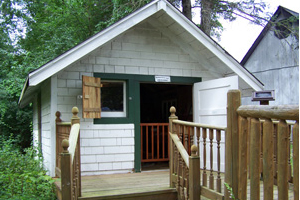 The Blain Playhouse was built in the early 1930's by Doctor Alexander Blain II, founder of the Blain Hospital, for his daughter Shirley.
The Blain Playhouse was built in the early 1930's by Doctor Alexander Blain II, founder of the Blain Hospital, for his daughter Shirley.
In 1947, Dr. Blain gave the playhouse to Vernon Price, who had worked part-time on the island since 1938, for his daughter Dorothy. The playhouse was loaded on a flatbed and taken over the log bridge off the island and transported to 5390 Elizabeth Lake Road.
The playhouse remained there until the mid 60's when it was given to John and Vivian Borkowski.
John Borkowski and Ray Lalone rolled the playhouse on well-drilling pipes up the hill from where it had been since 1947 to 5350 Elizabeth Lake Road, residence of John and Vivian Borkowski.
In December 1997, the playhouse was donated to the Waterford Historical Society by Vivian Borkowski. It was again loaded on a flatbed and moved to 4490 Hatchery Road, home of the society. The move was financed by two generous Waterford residents who are interested in preserving the past for future generations.
Back To Top
Historic Waterford Village
The idea of a “Turn of the Century” Village was conceived in 1996 after President Joy Smith took a trip to Ludington and visited White Pines Village. A complete historic village was put together by their local historical society. Some of the buildings were original and moved to the site while others were reconstructed. It was such a great idea.
The idea was passed on to a few of the members and the interest grew. We started wondering if we could do something like that on our 8 acres at Fish Hatchery Park. We already had the 1919 Hatchery House, home of the assistant manager and then the manager of the Fish Hatchery. We moved the 1930 log cabin to our site in 1994 and saved it from demolition. It was restored and is used as a museum and store. The 1930’s playhouse that was built on Blain Island was donated by the Borkowskis and moved to our location in 1997.
The following year, 1998, member Craige Keen found out about a 1957 Grand Trunk Caboose that was being taken off the line and going up for sale. Mike Kowall, our state Representative and also a train enthusiast, helped negotiate the deal. It arrived by rail at TTX on Williams Lake Rd. and trucked to our site. We cleaned and restored the interior.
We had a head start on the village with all the buildings we moved into the park. We needed a plan so a Village committee was formed in 1999. Our ideas were big and we were enthusiastic about it. We had the plans drawn up and the Township Planning Board passed them in 2000.
Then we started building and haven’t stopped. Historic Waterford Village will have a 1900’s feel and be a true representation of Waterford at the turn of the century. This village will be a proud addition to Waterford, a small Greenfield Village if you will. We know it will take many years to finish building our dream, but with the faith the community has placed in us and the enthusiasm that has been shown in the people who are working with us, we know it will continue to become a reality.
Back To Top
Jacober’s General Store
 Jacober's Store was built in 1856 by Horace Huntoon and John Griffen on the southwest corner of Dixie Highway and Andersonville Road. It was owned by Phineas Huntoon from 1860 - 1903. The store was idle for a few years but the second floor was used as a justice court, and a dance hall. August Jacober purchased the store in 1917 and ran it until Henry Ford purchased it for $700 in 1927. Henry Ford had it moved to Greenfield Village where it still stands with the name of J.R. Jones, one of the owners at the turn of the century. August Jacober built another store in the same location and ran it until 1957 when he sold it to the Community National Bank. Construction of a replica of Jacober's Store was begun in 2001 at our site in Fish Hatchery Park in Historic Waterford Village. Our store is a representation of the early 1900’s and is called Jacober’s Store after August Jacober.
Jacober's Store was built in 1856 by Horace Huntoon and John Griffen on the southwest corner of Dixie Highway and Andersonville Road. It was owned by Phineas Huntoon from 1860 - 1903. The store was idle for a few years but the second floor was used as a justice court, and a dance hall. August Jacober purchased the store in 1917 and ran it until Henry Ford purchased it for $700 in 1927. Henry Ford had it moved to Greenfield Village where it still stands with the name of J.R. Jones, one of the owners at the turn of the century. August Jacober built another store in the same location and ran it until 1957 when he sold it to the Community National Bank. Construction of a replica of Jacober's Store was begun in 2001 at our site in Fish Hatchery Park in Historic Waterford Village. Our store is a representation of the early 1900’s and is called Jacober’s Store after August Jacober.
Grand Trunk Caboose
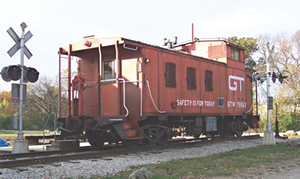
The caboose project was initiated in August of 1998 by member Craige Keen. Grand Trunk was going to retire all cabooses and we decided it would be a great idea to have one to preserve for future generations. When we contacted them we found out they were being sold for $8000.
In the winter of 1998, Craige Keen and Dick Lohff went to Adrian/Blissfield to see the cabooses that were going to be retired. Caboose #79063 was selected.
In May of 1999, Mike Kowall, State Representative, visited our railroad artifacts exhibit and became involved. He contacted people in Lansing and arranged to get a caboose for $4000 at the end of the summer when the caboose was retired. It had been recommissioned for road work between Flatrock and Battle Creek.
The caboose arrived on the track at TTX Draco on Williams Lake Road on July 26, 1999 and was moved July 28, 1999 to the Hatchery House site. Rep. Mike Kowall, Waterford Township Supervisor Katherine Innes, Waterford Parks & Recreation Director Dick Cartmill, President Joy Smith and members of the society watched as the caboose was lifted from the wheels, or trucks, and placed on a flatbed by a crane. At 11:30 the caboose left TTX on its way to its final home. By 12:30 the caboose was sitting on the tracks at the Fish Hatchery Park.
Currently the restored caboose serves as a railroad museum in our Historic Waterford Village. A caboose functioned as a home away from home for the trainmen and crew. Our caboose weighs 28 tons, is 40' long, 10' wide and 15'9" high. It was manufactured November of 1957. There are 3 bunks, one long desk, a chair, a sink with water tank, two seats in the cupola, a stove, small refrigerator and toilet.
In years to come, the only cabooses you see will be the ones that have been restored. They are considered obsolete. We hope the residents of Waterford, both young and old, will enjoy seeing an important part of the history of railroading.
Back To Top
Drayton Plains Depot
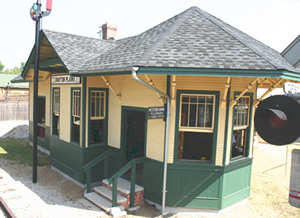
The original depot was built in 1908 by Detroit Haven & Milwaukee Railway. a subsidiary of Grand Trunk Railroad System on the northeast corner of Hatchery Road and Saginaw Trail on the south side of the tracks. It was a Lake Victorian-asymmetrical roof line, octagonal tower end design with turned decorative spindles. The building was 40 ft. long, 12 feet wide and has overhands of 3 ft. on the main building and 5 1/2 ft. on the waiting room.
Students rode the train from the depot to Pontiac High School. Block ice cut from Loon Lake was shipped by rail to points south and the Conservation Department shipped live fish, raised at the hatchery on Hatchery road.
The depot was closed in 1957, declared an "eyesore" in 1964 and was demolished in 1965. The only thing left was the sign.
It was rebuilt in 1995-95 at 203 Jones St. in Holly under the direction of Rich Welsh. He gave the depot to the Waterford Historical Society so that it may be saved for future generations. The Society moved the depot to its permanent location in Historic Waterford Village in September 2001. Currently the Depot is restored as if the conductor just stepped out to check on the next train to Pontiac.
Back To Top
Hardware Store

As saw mills sprang up in early towns, people needed more specialized tools to build and work with the wood. The need for these tools outgrew the space in the General Store and hardware stores came about. This was how most specialty stores began like clothing stores, millineries, book stores, and department stores. Many times the Hardware store also carried sporting goods, crockery for housewives and toys for children. Our Hardware Store is a representation of these early specialty stores. The funds for the store were donated by Dorothy Webber and named after her husband, Leon C. Webber and her father, John J. Crigger.
Back To Top
Lohff Print Shop
The following is the history about the printing press donated by the Lohff family as written for us by Richard Lohff.
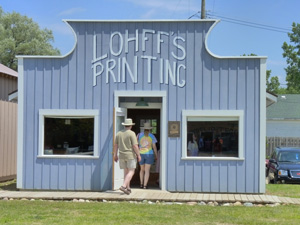 The press comes to us from the family of Theodore and Wilhelmina Lohff (Theo & Minnie.). Theo purchased the press used, in 1908 while living in Abrams, WI. The press was “invented in China, redesigned, revised, but still set up one letter at a time”. This means the press had drawers of type. One piece of type for each letter and maybe 100 of each letter of the alphabet in maybe three sizes. Each sheet was fed into the press one at a time.
The press comes to us from the family of Theodore and Wilhelmina Lohff (Theo & Minnie.). Theo purchased the press used, in 1908 while living in Abrams, WI. The press was “invented in China, redesigned, revised, but still set up one letter at a time”. This means the press had drawers of type. One piece of type for each letter and maybe 100 of each letter of the alphabet in maybe three sizes. Each sheet was fed into the press one at a time.
In 1908 Theo had leased a grocery store with an apartment upstairs and various out buildings. The lease for the store was $150 a year. That store was just replaced in 1996 with a new U.S. Post Office building.
The press was to be used to print all of his signs for the store to save money. As time went by Theo found he liked the printing work better than the grocery business. Theo and his family moved to Iron River, Iron Mountain, Manistee, and finally settled in Pontiac around 1923. When the family moved so did the press. Copies of things found with the press indicate the press was used each place they lived. Theo also was an architect, land developer, carpenter and father of five. Theo and Minnie settled in Pontiac as did three of the children who stayed in the Pontiac area and eventually settled in Waterford.
One reason the press never left the family was that, during the great depression, the press was used to print ads for local businesses, which kept the family afloat. In 1941 Theo died. Around 1945 Minnie sold the home. Their son, Francis saved the press, saying it got the family through one depression and we may need it again.
The press is currently in our print shop where we hope to someday get it up and running.
Our thanks to the Lohff family for their generosity in passing on this valued piece of machinery from the past.
Back To Top
Carriage House
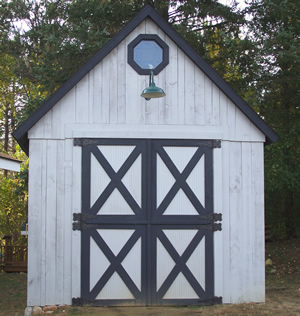
Carriage houses were common before automobiles as a place to store a horse-drawn carriage and all the necessary tack. Our carriage house is currently being used for storage and a workshop.
Back To Top
Outhouse
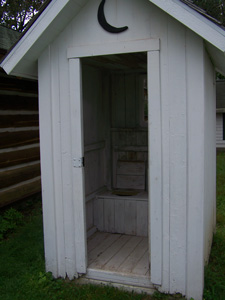
Our outhouse was donated by the Waterford Fire Department and came from property on Crescent Lake Road. Before indoor plumbing existed, the outhouse was part of normal everyday life. As toilet paper was a luxury, old Montgomery Ward or Sears catalogs were used and were also handy for reading material. Ours is a two-seater.
Back To Top
Watchpocket Building
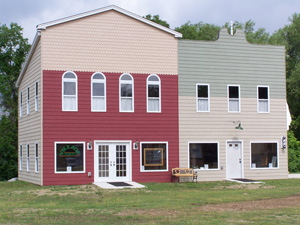
The Watchpocket Building houses five different businesses. The Watchpocket Building and Bakery are named after the Ellsworth Watchpocket Family. A bakery in the early 1900s served the same function as today, to provide fresh baked bread, pastries, cookies, cakes and pies to the public. Some Bakeries branched out into candies and would install a soda or ice cream fountain.
Marge & Irene�s Millinery is named after the mothers of The Dick & Carol LeMarbe Family. Millineries, most often owned by women, carried all types of ladies hats, gloves and accessories . Many of these shops would also carry clothing or have the ability to custom make clothing for women. This was one of a few well respected professions for women in the early 1900s.
The Village Barber Shop is a one chair shop. Early 1900s Barber shop�s functioned, not only as a place to groom the men in a town, but also as a popular center for daily news and gossip. Our circa 1880 chair was donated by the White Lake Historical Society.
The Doctor�s Office represents a typical town doctor of the early 1900s. Cramped and simply furnished, the doctor�s office was a no-frills place with very little privacy. This was a time when the medical field was just discovering the importance of germs, hand washing and sterilization.
The Dentist�s Office also represents an early time in dentistry. Dr. J. Keith Schachern purchased the dentist chair from Ransom & Randolph in Detroit, to start his practice at 28 1/2 W. Huron Street in Pontiac in 1937.
Back To Top
Nelson's Filling Station
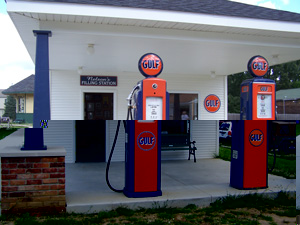
Our Station was started in 2010 on our property and represents the early 1920s when automobiles began replacing horse and buggy as the preferred mode of transportation.
At first motorists had to buy their gas in cans from general stores. Next came hand pumps in tanks at the curbside in front of these stores. Then small buildings were built just to sell gas. These were called �filling stations�. Next service areas were added to these buildings and became full service gas stations. Starting in 1982 self-serve stations became the norm and nowadays, full service stations are virtually nonexistent.
Back To Top



